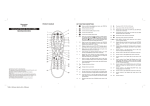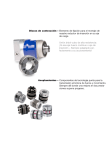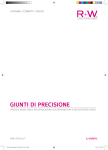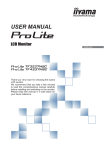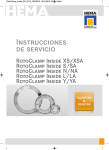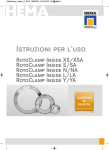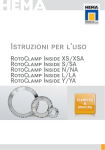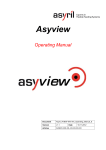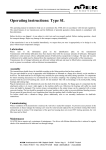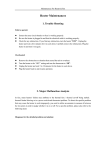Download Operating instructions: ATEK right angle drive gear units
Transcript
Operating instructions: ATEK right angle drive gear units This operating manual is intended to help you to commission the ATEK drive in accordance with relevant regulations. The stated features of our transmissions and the fulfilment of potential guarantee claims depend on compliance with these directions. Before the drive was shipped , it was subject to strict tests and was properly packed. Before starting operation , check for transport damage. Report any damage to the transport company immediately. If the transmission is not to be installed immediately, we request that you store it appropriately to its design in a dry place without mayor temperature changes. For long-time storage (over 3 months) please refer to our special specification for storage and preservation! Lubrication Please refer to the information given on the identification plate on the transmission! Transmissions with lifetime lubrication have been factory fitted with the necessary amounts of lubricants. Subsequent lubrication is only necessary when a substantial amount of lubricant has escaped due to leakage. The type and viscosity of lubricant to be added must be obtained from the manufacturer whilst stating the serial number of the transmission. Transmissions for oil change lubrication are delivered without lubricant and must be filled before commissioning with an oil or grease in accordance with our lubricant recommendation. Assembly The transmissions should always be installed according to the fitting position that has been ordered. The gear unit should be set up on appropiate solid foundations or mounted as a flange drive directly on the machine to be driven. The shaft ends have to be aligned very carefully for quiet running and safety during operation. To compensate for minor mounting inaccuracies we recommend the use of elastic couplings. The couplings must be warm or must be mounted with the aid of D-centring and a screw. Do not hammer! This will avoid damage to the tooth profile, rolling bearings and locking rings. Plug-in transmissions can be fitted directly onto the shaft of the driven machine. For flange gears it is important that the attachment surface is it excact right angles to the machine shaft's axis. Otherwise the bearings will suffer too much stress and might be damaged. The reaction torque corresponding to the output torque can be supported with a torque converter bearing. The bar should be mounted on the gears' machine side in order to prevent additional bending stresses. Do not mount the gears directly on a foundation plate when the machine shaft is bedded near the gears. For hollow shafts with a shrunk-on flange, please additionally refer to our assembly instructions for shaft-hub-connections. 1 Motor mounting information Commercially available standard three-phase motors of the IEC 72-2 / DIN 42677 unfortunately do not always correspond to the valid industry standards. Before assembly, the motor is to be checked for radial divergence of the shaft and also for coaxial deviation and axial run-out of the flange. With transmissions from the VLM series (hollowed drive shaft for the direct insertion of the motor shaft) we recommend striving for the following values of DIN 42955 R. Higher deviations lead to an increased load on the bearings and the teeth. These increased loads can cause a premature transmission failure. l/2 Bild 1. d 1. Check of the motor tolerances d Warning: You may only assemble the motor if you have carefully read through the mounting instructions on the back of this page and understood them and if you are authorized and have proper skills ! 1.1 Concentricity of the shaft end l/2 Table 1 (DIN 42955) Diameter of the cylindrical shaft end d up to 10 10 to 18 18 to 30 30 to 50 50 to 80 Concentricity tolerance N (normal) R (reduced) 0,03 0,015 0,035 0,018 0,04 0,021 0,05 0,025 0,06 0,03 Pic. 1 Bild 1. Mounting flange Centering diameter b1 40 to 100 100 to 230 230 to 450 Coaxiality tolerance and run-out tolerance N (normal) R (reduced) 0,08 0,04 0,1 0,05 0,125 0,063 1.3 Run-out tolerance of the flange surface to the axis of the shaft end It is recommended to measure with the shaft in the vertical position in order to eliminate the gravitational influence of the shaft on the measuring instrument. Pic. 2 b1 Bild 2. 10±1 Table 2 (DIN 42955) 10±1 1.2 Coaxiality tolerance for the centering shoulder Pic. 3 b1 1.4 Axial run-out This is measured on the radius equivalent to the sum of the outside diameters, the pitch circle diameter and the bolt holes. In order to eliminate the influence Bild 3. of an axial displacement of the shaft, the measurement must be repeated after the actuating arm has been offset through 180° in relation to the shaft. The mean value from the two measurements is decisive for the evaluation of the accuracy. It is recommended to measure with shaft in the vertical position in order to eliminate the play in the axial bearing. 2. Motor assembly The motor shaft and the transmission shaft are to be cleaned before assembly. Height and width of the parallel key on the motor are measured and compared with the dimensions of the hollowed drive shaft. Deformation on the motor shaft, the flanges or the parallel key are to be reworked. 2 To avoid frictional corrosion, the motor shaft and the transmission shaft are to be treated with a separating agent. The position of the parallel key/parallel key groove is to be aligned such that the drillings of the mounting flanges are almost congruent. If necessary, the motor or the transmission is fitted vertically with the use of a lifting gear. The parallel key connection must be able to be fitted together without notable resistance. Wedging of the two parts and impacts on one of the two drive components are to be avoided as they can cause premature transmission failure. The mounting holes of the connecting flanges are to be aligned to each other. For ease of assembly, we recommend to loosening the motor brake on larger drive units. Before tightening the flange connection, checks should be made by means of measuring shims, to ensure that the two flange surfaces are touching on their entire circumference. Only then should the fixing bolts are to be tightened crosswise. Motor mounting play-free, elastic couplings The axial, play-free plug-in shaft coupling with integrated frictionally engaged shaft-to-hub connections, permits a simple blind assembly and consists of 3 parts: 1. Conical hub, already mounted on the drive shaft of the transmission. 2. Plastic involute annular gear 3. Clamping hub type KN or KNN or clamping ring hub (2 parts) type SN The power is transmitted by frictional engagement between the functional surfaces. With type KNN an additional interlocking is achieved with the use of a parallel key. Particular attention must be paid to the controlled tightening of the locking screws or draw spindles and to the condition of the contact surfaces. Tolerance for fitting of motor shaft - hub k6/H7. The torques indicated in the catalogue may change with other shaft tolerances – please contact ATEK – Technique for further information. Assembly of clamping hub on to the motorshaft Clean and degrease the hub bore and the shaft. Release the clamping srew slightly – push the hub onto the shaft – measure dimension A at the gear unit - adjust dimension B (from table 3). Tighten the clamping screw with the tightening torque indicated in table 1. Table 1 Size of coupling Diameter D [mm] Clamping screw DIN 912 Pulling torque TA [Nm] 14 30 M3 1,34 19/24 40 M6 10,5 24/28 55 M6 10,5 28/38 65 M8 25 38/45 80 M8 25 Assembly of clamping ring hub on to the motorshaft Clean the hub bore and the shaft and oil them afterwards with liquid oil (e.g. with Castrol 4 in 1). Caution: Do not use oil and grease with molybdenum disulphide or other high pressure additions as well as sliding grease pastes. Release the clamping screws slightly and pull of the clamping ring slightly from the hub, so that the clamping ring is released. Push the clamping ring hub on to the motorshaft - measure dimension A at the gear unit - adjust dimension B ( from table 3). Tighten the clamping screws crosswise and evenly until the tightening torque indicated in table 2 is reached. Repeat this until all clamping screws reach this tightening torque. Table 2 Size of coupling Diameter D [mm] Clamping screws Pulling torque TA [Nm] 14 30 4xM3 1,34 19/24 40 6xM4 2,9 24/28 55 4xM5 6 28/38 65 8xM5 6 38/45 80 8xM6 10 øD S 3 Servomotor A A B Typ VC Typ SLC Table 3 Size of coupling Diameter D [mm] Distance dimension S Dist. dimension B = (A - S) 14 30 1,5 A - 1,5 19/24 40 2 A-2 24/28 55 2 A-2 28/38 65 2,5 A -2,5 38/45 80 3 A-3 Gear motor assembly The installation in hazardous locations is not permitted, except with motors that have the appropriate approval. The supplied type of protection and thermal class are to be compared with the conditions in the place of installation. A stoppage heating is recommended for locations that have a large variation in temperature or high air humidity. Attention has to be paid to sufficient admission of fresh air and unobstructed cooling fins as well as open air intakes an outlets on the ventilator. The distance between the air inlet opening and the nearest wall should be equivelent to at least half the diameter of the motor. For vertical mounting with the ventilator mounted above the motor, we recommend ventilator cover or a cover integrated into the equipment. The foundation work must be executed evenly, cleanly and durably and has to be dimensioned to withstand the occuring moments of torques. Misalignment in the drive system, as well as shock and unbalanced parts must be avoided. Checks before commissioning Before commissioning the insulation resistance of the engine coils must be checked. It should be higher than 5MΩ at 25°C. If this value is not achieved, a specialist must be consulted. Electrical connections The motor may only be connected by competent personnel. The electrical connection must correspond with the valid safety regulations. The power and current data must correspond with the data of electrical mains supply. Voltage and frequency fluctuations are subject to DIN EN 60034-1. 50Hz motors can be connected to a 60Hz mains supply if the change in the power, voltage, torque and number of r.p.m. are considered. All cross-section of all connecting cables must be adequately dimensioned (DIN VDE 0298). The grounding connection is located in the proximity of, or directly in the terminal box. Cable entries are to be provided with screwed connections according to DIN 46320/T1. Direction of rotation Transmissions with standard motors can be connected in both directions of rotation. When viewing the the end of the transmission shaft, the direction of rotation “right“ means that the shaft is turning in the clockwise direction. For checking the direction of rotation, the drive should be operated first in its installation position without any machine parts connected (refer to the fitting instructions). We recommend first connecting the phase sequence L1, L2, L3 to the clamps U1, V1 and W1. A change to the direction of rotation can subsequently be made swapping any two cables. Motor-protection mechanisms To protect the drive unit against a short-circuit, overload or single-phase operation, sufficiently dimensioned protective switches or fuses with thermal overcurrent relays should be fitted. Installed PTC feelers (thermistors) are to be connected to a suitable actuating device. Thermostats are prewired for automatic switching. 4 Starting squirrel cage motors If direct engagement is selected as the starting procedure for the drive, the electrical mains supply connected and the supply lines must be able to carry the starting current. If the connected machine does not need an increased starting torque (the resistive torque of the machine is smaller than the rated load torque of the drive), the star-delta starting is to be preferred. This avoids the strong initial jolt and with frequent starting procedures, the life span of the drive is increased. The starting current and the starting torque are approx. 30% lower than during direct engagement. The switching of the star into the delta connection should be made at approximately the nominal motor speed. Otherwise, the switching current is almost as large as during direct engagement. The motoe can also be started through the use of starting transformers, intermidiate resistors or stator resistors. These are connected to the terminals of the terminal box and cause the reduction of torque in proportion to the square of the voltage and of the reduction of the nominal current linear with the voltage. STAR - Connection W2 U2 V2 U1 V1 W1 L1 L2 L3 DELTA - Connection W2 U1 L1 U2 V2 V1 L2 W1 Connection: STAR- DELTA W2 U2 V2 U1 V1 W1 L3 Commissioning Where ventilation of the transmission is desired, the vent hole is sealed for transport. To prevent excess pressure in the transmission an hence leakage the locking screw must be removed and replaced by the provided venting filter before setting the gear in motion. If the temperature of the gear box housing does not exceed 50°C during operation, the vent filter must not be fitted. Maintenance All ATEK drives require only a minimum of maintenance. For drives with lifetime lubrication this is reduced to regular checks of the transmission for lubricant loss through leakage. For transmissions with oil change lubrication please refer to our lubricant recommendation. 5





